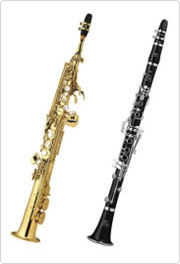The Structure of the Saxophone
The saxophone is a conical-bored instrument
Are the saxophone and the clarinet similar?
The soprano saxophone and the clarinet look similar at first glance, but they are completely different. First, the clarinet is cylindrical. It seems to swell slightly in the middle sometimes, but it is essentially a straight cylinder. The soprano saxophone, on the other hand, is a progressively widening cone.
The alto, tenor, and all saxophones are conical. The inventor, Adolphe Sax, designed the first saxophone as a conical tube with a three-degree taper.
"Taper" means to become progressively narrower toward one end, and, with musical instruments in particular, it indicates the angle of the graduation of the taper. For example, it might be easier to imagine if you think of an umbrella that is partially opened. A different taper will give a completely different tone and pitch.
Because it is tapered and not cylindrical, the saxophone can produce a sound that is very similar to the human voice. This gives it a wide range of emotional expression, and makes it ideal as a solo instrument.

A soprano saxophone (left) and a clarinet (right)
